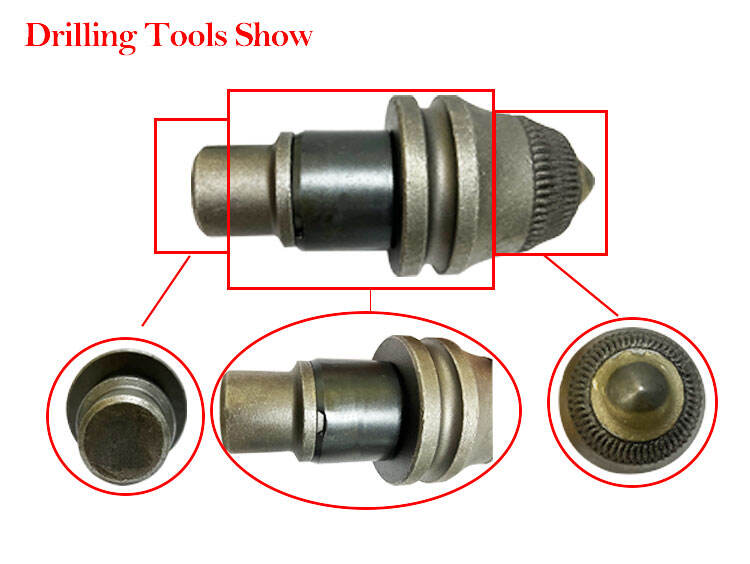Functional Anatomy of Hydraulic Breakers and Chisels
Core Components: Piston, Chisel, and Cylinder Assembly
Hydraulic breakers rely on three precision-engineered components:
- Piston: Driven by hydraulic pressure to generate kinetic force
- Chisel: Hardened tool-bit that transfers impact energy to work surfaces
- Cylinder Assembly: Houses control valves and guides piston movement
A nitrogen-charged back head cushions recoil, while the front head connects the chisel to the piston rod. Configurations vary by application, from pyramidal tips for concrete to blunt moils for trenching.
Energy Conversion: Hydraulic Pressure to Kinetic Force
Pressurized hydraulic fluid (150–350 bar) lifts the piston, storing potential energy. When released, the piston accelerates downward at 8–15 m/s, delivering 1,000–5,000 Joules per strike with ≥70% efficiency. Impact concentrates on a ≤2 cm² contact area, exceeding material compressive limits.
Material Science in Breaker Tool Manufacturing
Chisels use ultrahigh-carbon steels (0.6–0.8% C) alloyed with chromium (1.5–2.5%) and vanadium (0.1–0.3%) for durability. Key treatments include:
- Austempering for bainitic microstructures (45–52 HRC hardness)
- Laser-cladding with tungsten carbide on tips
- Stress-relief annealing (550–600°C) for microfracture prevention
Front heads use abrasion-resistant steels (400–500 HB), while cylinder bores maintain ≤1.6 µm roughness to minimize friction.
Classification Spectrum of Hydraulic Breakers
Top-Type vs Side-Type Breaker Configurations
- Top-type: Vertical impact for downward-force tasks (e.g., pavement breaking).
- Side-type: Horizontal orientation for confined spaces (e.g., trenching). Box-type silent variants reduce noise by 8–12 dB while maintaining 1,800–2,200 ft-lbs impact energy.
Medium-weight breakers (150–500 kg) dominate 62% of fleets due to power-mobility balance.
Heavy-Duty vs Compact Models: Application Matrix
Specialized Variants: Moil Points and Hammer Attachments
- Moil points focus 85% energy in a 2" zone for precision rock breaking.
-
Flat chisels distribute force across 6–8" for concrete fragmentation.
Quick-change mounts reduce tool swaps from 45 minutes to under 90 seconds.
Strategic Deployment in Construction and Mining
Urban Demolition: Precision Control Requirements
Advanced models limit peak particle velocity to 5 mm/s (60% below standard thresholds) using accelerometer-based monitoring. Dual-stage pressure regulation enables 700–1,200 RPM shifts, while noise shrouds reduce emissions to 82 dB(A).
Quarry Operations: Throughput Optimization
A 2,000 ft-lb breaker with 35–45 Shore hardness chisels fragments basalt at 28–32 tons/hour—40% faster than pneumatic tools. Auto-rotation adapters maintain 98% strike contact over 10-hour shifts, and smart hydraulics cut idle fuel use by 18%.
Case Study: Tunnel Excavation with Box-Type Breakers
A railway project excavated 1.4 miles of rock with 0.5-meter accuracy using square chisels (35% less secondary drilling vs. moil points). Dust suppression kept particulates below 2 mg/m³, and predictive maintenance extended service to 400 hours.
Technological Evolution in Hydraulic Fracturing Systems
Intelligent Impact Frequency Modulation
Sensor-driven algorithms adjust strike rates by material hardness, saving 18–22% energy in concrete demolition. Adaptive frequency reduces wear by 35%, extending tool life beyond 2,000 hours in granite.
Energy Recovery Systems: Regenerative Hydraulics
Captured rebound energy supplements power in cyclic operations like quarry work.
Electric vs Diesel Power Sources
Electric models suit urban projects (≤85 dB), while diesel excels in high-torque mining. Upfront costs balance within 18 months via fuel savings.
Operational Economics and Maintenance Protocols
Predictive Maintenance: Vibration Analysis
Accelerometer-based FFT analysis predicts failures 72 hours in advance, cutting downtime by 35%. Combined with thermal imaging, it reduces annual part costs by $18,000.
Total Cost of Ownership
Optimized settings slash fuel use by 28%, while preventive upkeep adds 300–400 service hours.
Tool Lifecycle Management
RFID tracking and digital twins enable wear analysis and re-tip scheduling. Automated rotation boosts chisel life by 40%, saving $62,000/year in consumables. Re-tempering at 20% wear depth cuts disposal costs by 55%.
FAQ
What are the core components of a hydraulic breaker?
The core components of a hydraulic breaker are the piston, chisel, and cylinder assembly.
How does a hydraulic breaker convert energy?
Hydraulic breakers convert energy through pressurized hydraulic fluid lifting the piston, releasing kinetic energy via the chisel.
What materials are used in breaker tool manufacturing?
Breaker tools employ ultrahigh-carbon steels alloyed with chromium and vanadium, and undergo austempering and other treatments.
What are the special variants of hydraulic breakers?
Special variants include moil points for precision rock breaking and flat chisels for concrete fragmentation.
Why are electric power sources beneficial for hydraulic breakers?
Electric power sources are suitable for urban projects due to lower noise and emissions compared to diesel systems.




